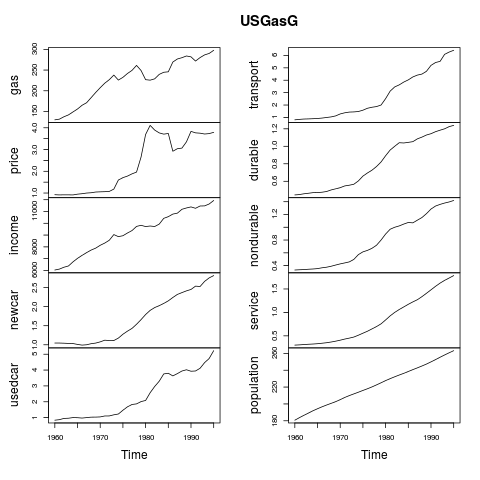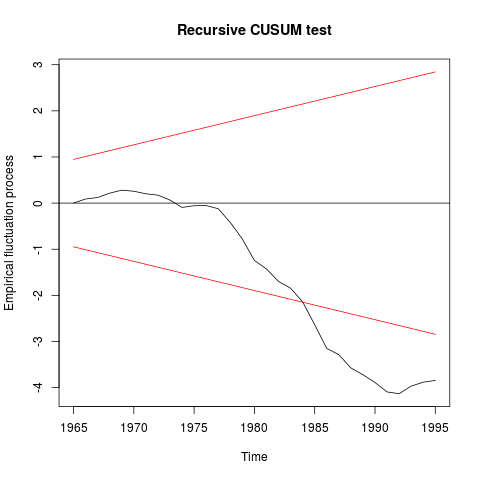Supported by Dr. Osamu Ogasawara and  providing providing  . . |
|
Last data update: 2014.03.03 |
US Gasoline Market Data (1960–1995, Greene)DescriptionTime series data on the US gasoline market. Usagedata("USGasG")
FormatAn annual multiple time series from 1960 to 1995 with 10 variables.
SourceOnline complements to Greene (2003). Table F2.2. http://pages.stern.nyu.edu/~wgreene/Text/tables/tablelist5.htm ReferencesGreene, W.H. (2003). Econometric Analysis, 5th edition. Upper Saddle River, NJ: Prentice Hall. See Also
Examples
data("USGasG", package = "AER")
plot(USGasG)
## Greene (2003)
## Example 2.3
fm <- lm(log(gas/population) ~ log(price) + log(income) + log(newcar) + log(usedcar),
data = as.data.frame(USGasG))
summary(fm)
## Example 4.4
## estimates and standard errors (note different offset for intercept)
coef(fm)
sqrt(diag(vcov(fm)))
## confidence interval
confint(fm, parm = "log(income)")
## test linear hypothesis
linearHypothesis(fm, "log(income) = 1")
## Example 7.6
## re-used in Example 8.3
trend <- 1:nrow(USGasG)
shock <- factor(time(USGasG) > 1973, levels = c(FALSE, TRUE),
labels = c("before", "after"))
## 1960-1995
fm1 <- lm(log(gas/population) ~ log(income) + log(price) + log(newcar) +
log(usedcar) + trend, data = as.data.frame(USGasG))
summary(fm1)
## pooled
fm2 <- lm(log(gas/population) ~ shock + log(income) + log(price) + log(newcar) +
log(usedcar) + trend, data = as.data.frame(USGasG))
summary(fm2)
## segmented
fm3 <- lm(log(gas/population) ~ shock/(log(income) + log(price) + log(newcar) +
log(usedcar) + trend), data = as.data.frame(USGasG))
summary(fm3)
## Chow test
anova(fm3, fm1)
library("strucchange")
sctest(log(gas/population) ~ log(income) + log(price) + log(newcar) +
log(usedcar) + trend, data = USGasG, point = c(1973, 1), type = "Chow")
## Recursive CUSUM test
rcus <- efp(log(gas/population) ~ log(income) + log(price) + log(newcar) +
log(usedcar) + trend, data = USGasG, type = "Rec-CUSUM")
plot(rcus)
sctest(rcus)
## Note: Greene's remark that the break is in 1984 (where the process crosses its
## boundary) is wrong. The break appears to be no later than 1976.
## More examples can be found in:
## help("Greene2003")
Results
R version 3.3.1 (2016-06-21) -- "Bug in Your Hair"
Copyright (C) 2016 The R Foundation for Statistical Computing
Platform: x86_64-pc-linux-gnu (64-bit)
R is free software and comes with ABSOLUTELY NO WARRANTY.
You are welcome to redistribute it under certain conditions.
Type 'license()' or 'licence()' for distribution details.
R is a collaborative project with many contributors.
Type 'contributors()' for more information and
'citation()' on how to cite R or R packages in publications.
Type 'demo()' for some demos, 'help()' for on-line help, or
'help.start()' for an HTML browser interface to help.
Type 'q()' to quit R.
> library(AER)
Loading required package: car
Loading required package: lmtest
Loading required package: zoo
Attaching package: 'zoo'
The following objects are masked from 'package:base':
as.Date, as.Date.numeric
Loading required package: sandwich
Loading required package: survival
> png(filename="/home/ddbj/snapshot/RGM3/R_CC/result/AER/USGasG.Rd_%03d_medium.png", width=480, height=480)
> ### Name: USGasG
> ### Title: US Gasoline Market Data (1960-1995, Greene)
> ### Aliases: USGasG
> ### Keywords: datasets
>
> ### ** Examples
>
> data("USGasG", package = "AER")
> plot(USGasG)
>
> ## Greene (2003)
> ## Example 2.3
> fm <- lm(log(gas/population) ~ log(price) + log(income) + log(newcar) + log(usedcar),
+ data = as.data.frame(USGasG))
> summary(fm)
Call:
lm(formula = log(gas/population) ~ log(price) + log(income) +
log(newcar) + log(usedcar), data = as.data.frame(USGasG))
Residuals:
Min 1Q Median 3Q Max
-0.065042 -0.018842 0.001528 0.020786 0.058084
Coefficients:
Estimate Std. Error t value Pr(>|t|)
(Intercept) -12.34184 0.67489 -18.287 <2e-16 ***
log(price) -0.05910 0.03248 -1.819 0.0786 .
log(income) 1.37340 0.07563 18.160 <2e-16 ***
log(newcar) -0.12680 0.12699 -0.998 0.3258
log(usedcar) -0.11871 0.08134 -1.459 0.1545
---
Signif. codes: 0 '***' 0.001 '**' 0.01 '*' 0.05 '.' 0.1 ' ' 1
Residual standard error: 0.03304 on 31 degrees of freedom
Multiple R-squared: 0.958, Adjusted R-squared: 0.9526
F-statistic: 176.7 on 4 and 31 DF, p-value: < 2.2e-16
>
> ## Example 4.4
> ## estimates and standard errors (note different offset for intercept)
> coef(fm)
(Intercept) log(price) log(income) log(newcar) log(usedcar)
-12.34184054 -0.05909513 1.37339912 -0.12679667 -0.11870847
> sqrt(diag(vcov(fm)))
(Intercept) log(price) log(income) log(newcar) log(usedcar)
0.67489471 0.03248496 0.07562767 0.12699351 0.08133710
> ## confidence interval
> confint(fm, parm = "log(income)")
2.5 % 97.5 %
log(income) 1.219155 1.527643
> ## test linear hypothesis
> linearHypothesis(fm, "log(income) = 1")
Linear hypothesis test
Hypothesis:
log(income) = 1
Model 1: restricted model
Model 2: log(gas/population) ~ log(price) + log(income) + log(newcar) +
log(usedcar)
Res.Df RSS Df Sum of Sq F Pr(>F)
1 32 0.060445
2 31 0.033837 1 0.026608 24.377 2.57e-05 ***
---
Signif. codes: 0 '***' 0.001 '**' 0.01 '*' 0.05 '.' 0.1 ' ' 1
>
> ## Example 7.6
> ## re-used in Example 8.3
> trend <- 1:nrow(USGasG)
> shock <- factor(time(USGasG) > 1973, levels = c(FALSE, TRUE),
+ labels = c("before", "after"))
>
> ## 1960-1995
> fm1 <- lm(log(gas/population) ~ log(income) + log(price) + log(newcar) +
+ log(usedcar) + trend, data = as.data.frame(USGasG))
> summary(fm1)
Call:
lm(formula = log(gas/population) ~ log(income) + log(price) +
log(newcar) + log(usedcar) + trend, data = as.data.frame(USGasG))
Residuals:
Min 1Q Median 3Q Max
-0.055238 -0.017715 0.003659 0.016481 0.053522
Coefficients:
Estimate Std. Error t value Pr(>|t|)
(Intercept) -17.385790 1.679289 -10.353 2.03e-11 ***
log(income) 1.954626 0.192854 10.135 3.34e-11 ***
log(price) -0.115530 0.033479 -3.451 0.00168 **
log(newcar) 0.205282 0.152019 1.350 0.18700
log(usedcar) -0.129274 0.071412 -1.810 0.08028 .
trend -0.019118 0.005957 -3.210 0.00316 **
---
Signif. codes: 0 '***' 0.001 '**' 0.01 '*' 0.05 '.' 0.1 ' ' 1
Residual standard error: 0.02898 on 30 degrees of freedom
Multiple R-squared: 0.9687, Adjusted R-squared: 0.9635
F-statistic: 185.8 on 5 and 30 DF, p-value: < 2.2e-16
> ## pooled
> fm2 <- lm(log(gas/population) ~ shock + log(income) + log(price) + log(newcar) +
+ log(usedcar) + trend, data = as.data.frame(USGasG))
> summary(fm2)
Call:
lm(formula = log(gas/population) ~ shock + log(income) + log(price) +
log(newcar) + log(usedcar) + trend, data = as.data.frame(USGasG))
Residuals:
Min 1Q Median 3Q Max
-0.045360 -0.019697 0.003931 0.015112 0.047550
Coefficients:
Estimate Std. Error t value Pr(>|t|)
(Intercept) -16.374402 1.456263 -11.244 4.33e-12 ***
shockafter 0.077311 0.021872 3.535 0.00139 **
log(income) 1.838167 0.167258 10.990 7.43e-12 ***
log(price) -0.178005 0.033508 -5.312 1.06e-05 ***
log(newcar) 0.209842 0.129267 1.623 0.11534
log(usedcar) -0.128132 0.060721 -2.110 0.04359 *
trend -0.016862 0.005105 -3.303 0.00255 **
---
Signif. codes: 0 '***' 0.001 '**' 0.01 '*' 0.05 '.' 0.1 ' ' 1
Residual standard error: 0.02464 on 29 degrees of freedom
Multiple R-squared: 0.9781, Adjusted R-squared: 0.9736
F-statistic: 216.3 on 6 and 29 DF, p-value: < 2.2e-16
> ## segmented
> fm3 <- lm(log(gas/population) ~ shock/(log(income) + log(price) + log(newcar) +
+ log(usedcar) + trend), data = as.data.frame(USGasG))
> summary(fm3)
Call:
lm(formula = log(gas/population) ~ shock/(log(income) + log(price) +
log(newcar) + log(usedcar) + trend), data = as.data.frame(USGasG))
Residuals:
Min 1Q Median 3Q Max
-0.027349 -0.006332 0.001295 0.007159 0.022016
Coefficients:
Estimate Std. Error t value Pr(>|t|)
(Intercept) -4.13439 5.03963 -0.820 0.420075
shockafter -4.74111 5.51576 -0.860 0.398538
shockbefore:log(income) 0.42400 0.57973 0.731 0.471633
shockafter:log(income) 1.01408 0.24904 4.072 0.000439 ***
shockbefore:log(price) 0.09455 0.24804 0.381 0.706427
shockafter:log(price) -0.24237 0.03490 -6.946 3.5e-07 ***
shockbefore:log(newcar) 0.58390 0.21670 2.695 0.012665 *
shockafter:log(newcar) 0.33017 0.15789 2.091 0.047277 *
shockbefore:log(usedcar) -0.33462 0.15215 -2.199 0.037738 *
shockafter:log(usedcar) -0.05537 0.04426 -1.251 0.222972
shockbefore:trend 0.02637 0.01762 1.497 0.147533
shockafter:trend -0.01262 0.00329 -3.835 0.000798 ***
---
Signif. codes: 0 '***' 0.001 '**' 0.01 '*' 0.05 '.' 0.1 ' ' 1
Residual standard error: 0.01488 on 24 degrees of freedom
Multiple R-squared: 0.9934, Adjusted R-squared: 0.9904
F-statistic: 328.5 on 11 and 24 DF, p-value: < 2.2e-16
>
> ## Chow test
> anova(fm3, fm1)
Analysis of Variance Table
Model 1: log(gas/population) ~ shock/(log(income) + log(price) + log(newcar) +
log(usedcar) + trend)
Model 2: log(gas/population) ~ log(income) + log(price) + log(newcar) +
log(usedcar) + trend
Res.Df RSS Df Sum of Sq F Pr(>F)
1 24 0.0053144
2 30 0.0251878 -6 -0.019873 14.958 4.595e-07 ***
---
Signif. codes: 0 '***' 0.001 '**' 0.01 '*' 0.05 '.' 0.1 ' ' 1
> library("strucchange")
> sctest(log(gas/population) ~ log(income) + log(price) + log(newcar) +
+ log(usedcar) + trend, data = USGasG, point = c(1973, 1), type = "Chow")
Chow test
data: log(gas/population) ~ log(income) + log(price) + log(newcar) + log(usedcar) + trend
F = 14.958, p-value = 4.595e-07
> ## Recursive CUSUM test
> rcus <- efp(log(gas/population) ~ log(income) + log(price) + log(newcar) +
+ log(usedcar) + trend, data = USGasG, type = "Rec-CUSUM")
> plot(rcus)
> sctest(rcus)
Recursive CUSUM test
data: rcus
S = 1.4977, p-value = 0.0002437
> ## Note: Greene's remark that the break is in 1984 (where the process crosses its
> ## boundary) is wrong. The break appears to be no later than 1976.
>
> ## More examples can be found in:
> ## help("Greene2003")
>
>
>
>
>
> dev.off()
null device
1
>
|

